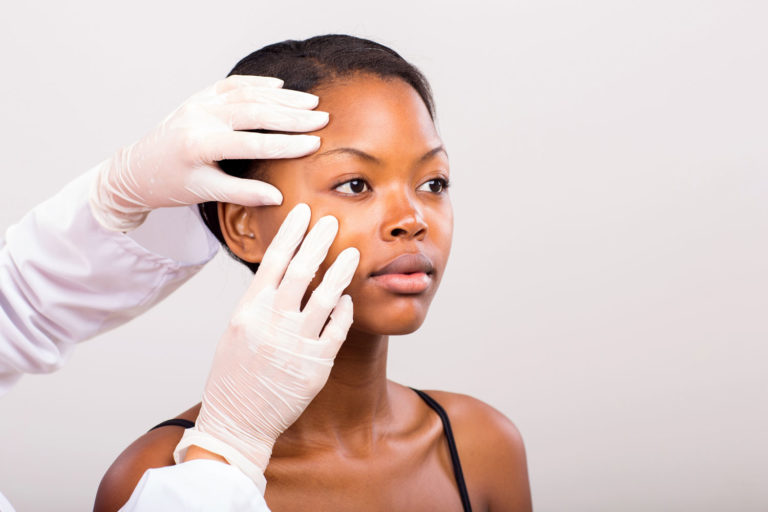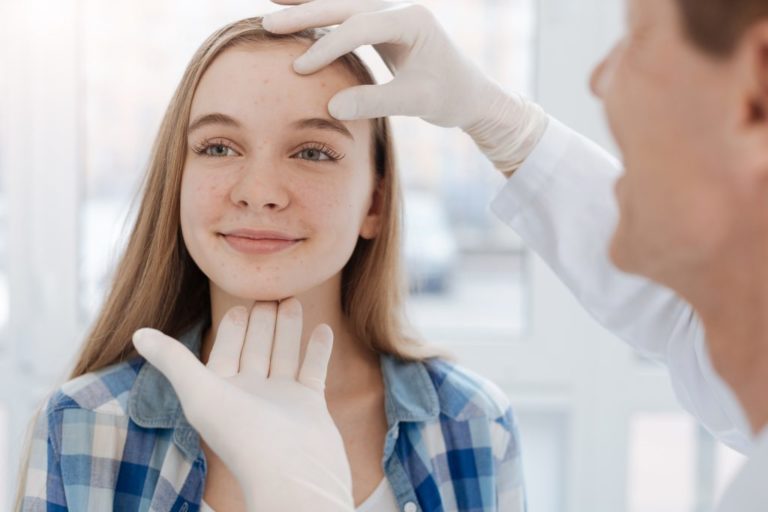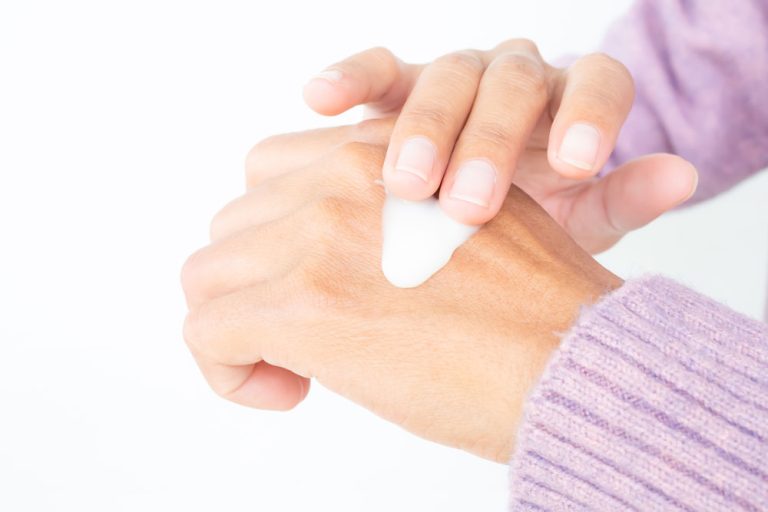
Vitiligo
What is Vitiligo? Vitiligo is a rare, chronic, skin condition due to the loss of pigmentation (melanin) when the pigment-producing cells (melanocytes) are attacked and
Home > Treatments > Chronic

What is Vitiligo? Vitiligo is a rare, chronic, skin condition due to the loss of pigmentation (melanin) when the pigment-producing cells (melanocytes) are attacked and

What is Rosacea? Acne rosacea is a chronic inflammatory skin condition that affects more than 14 million and is most common in fair skin types.

What is Psoriasis? Psoriasis is a chronic autoimmune condition that affects more than 7 million Americans and ranges in severity from mild to extremely severe.

What is Eczema? Eczema, or atopic dermatitis, is a common skin rash that makes your skin red, dry, and itchy. It is common in children

What is Dry Skin? Dry skin is unattractive, flaky, rough, and often itchy. Severe forms of it may become uncomfortable, scaly, crack or even bleed. It most
Being well-prepared for your appointment will ensure that the doctor has all of the needed information to provide the best possible care for you. It will also help alleviate any unnecessary anxiety you may be feeling prior to your first appointment. Educate yourself on your symptoms by reviewing the content on this Web site. Also, take some time to review our staff page and familiarize yourself with the doctors. We look forward to your first visit.
We accept most traditional insurance plans. Please contact our office to verify acceptance of your plan. Qualifications for insurance coverage may differ due to the uniqueness of each procedure. We are happy to file insurance for your reimbursement as long as you are free to choose your own dermatologist.
We accept checks or credit cards. We also offer a flexible payment plan. Please contact our Financial Coordinator for details.
Yes, we do!
We see patients of all ages.
Please visit our locations page, and select your office city to find directions. See our locations
We treat a wide variety of skin conditions, including but not limited to, rashes, skin lesions, skin cancers, acne, warts, hair loss, nail fungus, dry skin, rosacea, etc. See our treatments
After cleansing, apply a coating of Vaseline or polysporin. Keep ointment on the wound at all times until the wound is healed. Apply bandages over the wound for the first five to seven days.
Moles are more likely to grow back if you have a shave excision, as the procedure won’t be attempting to remove the entire mole.
Keeping the wound moist after the mole removal is essential and may help it heal up to 50% faster. Keeping it clean, bandaged, and hydrated with over-the-counter ointments like Vaseline as well as changing the bandage once or twice a day will help significantly.
Dark flat moles can be removed by Laser. Depending on the size of the mole, Laser mole removal may not remove the mole all at once. So, it may take more than one session to remove the mole.
Moles that begin crusting or scabbing can be an indicating factor for melanoma. A scabbing mole may be especially worrisome if it is also bleeding and/or painful. Other factors such as size, shape, color, or itching, can also be used to determine the severity of the mole.
If it seems suspicious and abnormal, then you may need to have it removed. Removing a suspicious mole and then examining it for cancer cells is an important step in catching melanoma early because catching it early is when it’s the easiest to treat.
Signs of a serious rash: Pain, warmth, swelling, crusting over of rash bumps, yellow discharge, green discharge, a bad smell.
Some relief measures to heal a rash: Cold compress, aloe vera, moisturizing lotion.
Rashes will last depending on the rashes cause. However, most rashes usually disappear within a few days.
Go to the emergency room if your rash is spreading rapidly. If the rash is spreading slower but is spreading over your body, it’s still a good idea to get it looked at immediately.
Every rash is different, some may be longer-lasting and will require long-term treatment to keep the rash under control. Whereas some rashes can usually clear up within 48 hours.
The signs of skin cancer are often associated with growth or lump on the skin. As well as, excessive redness and new swelling beyond the mole. Color also spreads past the mole and onto the surrounding skin. Some other symptoms that can be associated with skin cancer could be: Itching, pain, tenderness, and if a mole is oozing, scaling, and bleeding.
Early-stage skin cancer may resemble a small spot or discolored blemish that is smaller than the size of a fingernail. Its color can be identified by a red or brown hue. Sometimes white with flaking skin surrounded by blotches of darker skin.
The most common sign of skin cancer is associated with your skin changing. This can be associated with a growth, a sore that does not heal, or a change in a mole. Not all skin cancers look the same.
If skin cancer is left untreated, it can grow deeper into the skin and damage surrounding skin, tissue, and bone. It may even become aggressive and spread to other parts of the body and can become life threatening.
If the skin cancer is found early, it is highly treatable. Often times a dermatologist can treat early skin cancer by removing cancer as well as the surrounding skin.
Skin cancers often time don’t cause bothersome symptoms until they have grown large. At that point, they do hurt and may be associated with an itch and bleeding.
You should suspect skin cancer when a new, expanding, or changing growth, spot, or bump on the skin.
Some skin cancer lesions appear suddenly, others may grow slowly over time. For example, the crusty, pre-cancerous spots associated with actinic keratoses can take years to develop. While skin cancer like melanoma can appear suddenly. The lesions can vanish and reappear.
There isn’t much pain, in-fact the discomfort is minimal. There’s just the initial stick of the needle. You may feel a bit of pressure, but you oftentimes do not feel pain. Afterward, most patients only experience minimal pain.
Treating acne is a relatively slow and stepwise process. Patience is key since there is no overnight remedy. Each patient will have a customized treatment plan depending on their acne type and severity, location, skin type, and lifestyle.
Depending on the severity of your acne, there can be different topical ointments that may be recommended.
Ice will not cure pimples. It can, however, decrease swelling and redness, making the pimple less noticeable.
Certain kinds of toxins and bacteria will clog the pores on your epidermis can cause issues like acne and pimples. Drinking more water will ensure that you won’t suffer from severe pimples and acne. The more hydrated your skin is, the less your pores will clog.
Yes, going to a dermatologist is well worth it. Going to a dermatologist for acne can be one of the best things for your acne condition. You will be given guidance, treatments, and you will be able to avoid the issues that come with acne such as scaring, and dark spots.
Acne scar and dark spot treatments may be started to further improve the appearance of your skin. This may include cosmetic procedures, such as acne peels, micro-needling, etc.
There are a number of treatments for different types of cystic acne. Depending on the root cause for the cystic acne, it could be treated with a simple diet change with a topical ointment to potentially having extractions depending on the severity.
Some hormonally induced acne can be treated via Retin-A, Tretinoin, Differin, etc.
Vitamin A helps unplug the blocked-up content in whiteheads and blackheads.
Topical corticosteroids creams and ointments so that the inflammation can be reduced.
There is treatment that can help you feel better. You may need topical, oral, or body-wide treatments. Even with severe psoriasis, these methods are the best options to manage it. At this time there is no cure for psoriasis since it is a chronic skin condition.
The immune system and genetics play major roles in developing psoriasis but there are usually triggers that initiate flares. The autoimmune process causes the skin cells to shed at an abnormally fast rate, which causes the buildup of thick, red, scaly plaques. Some common triggers of psoriasis flares are illnesses that weaken the immune system like strep infection, stress, and physical trauma.
Stress can be a common trigger for a psoriasis flare. It can also make the itch worse. Stress management is particularly important if you suffer from psoriasis.
Psoriasis flare-ups are triggered by something. Scratching a psoriasis rash does not cause it to spread from one location to another. However, it may slow the healing process.
Yes, Vitamin D analogues: complements topical steroid treatments.
It is worse in the fall and winter, the combination of dry air and colder temperatures with fewer hours of sunlight can worsen the symptoms of psoriasis.
It can make it worse. Exfoliating with a scrub or loofah will get rid of dead skin cells and cause irritation to delicate skin that may cause new psoriasis patches.
The best fabrics for psoriasis would be: natural, super soft, lightweight, and breathable. Fabrics that are made from cotton, bamboo, and silk.
Mohs surgery is generally considered safe, but there could be risks. Such as bleeding from the site of surgery. Bleeding into the wound from surrounding tissue. Pain or tenderness in the area where the skin was removed.
Squamous is more serious because of its likelihood to spread.
If there was no cancer seen, the skin can be repaired, bandaged, and the patient is sent home cancer-free. The patient at that point will be free to drive themselves home if they feel comfortable.
Mohs surgery is covered by most plans, including Medicare.
If left untreated, basal cells can become quite large, cause disfigurement, and in rare cases, spread to other parts of the body and even cause death.
Mohs exam processes 100 percent of the tissue margins, whereas in standard surgical excision only 1 percent of the margins are examined microscopically.
There is an alternative such as SRT. SRT stands for superficial Radiation Therapy. It is able to cure cancer without ever invading the skin of a patient.
Very slow. The tumors enlarge at a slow rate, sometimes so slow that they go unnoticed as new growths.
You can tell an infection has occurred when you experience fever and local symptoms such as redness, pain, warmth, swelling, and drainage of pus or cloudy fluid at the wound site within several days.